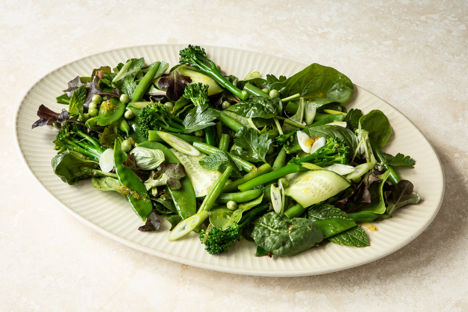A vinaigrette is the most classic of dressings. Sometimes known as French dressing, the basic dressing starts out as vinegar, oil and salt, which is really all it takes to bring a simple salad to life.
Light and tart, vinaigrettes are the perfect pairing for delicate salad leaves. While robust romaine and crisp iceberg can stand up to creamier, heavier dressings, light vinaigrettes are the best partner for more delicate leaves like rocket or baby spinach. Samin Nosrat has a handy ‘salad axis’ illustrating this beautifully, but essentially the lighter the leaf, the lighter the dressing.
Which type of vinegar should you use for vinaigrette?
The difference a quality olive oil makes in cooking has been discussed in many a cookbook, but the quality of vinegars is less well-known. The right vinegar is, unsurprisingly, essential to making a delicious vinaigrette. However, ‘right’ doesn’t necessarily mean expensive. Aged sherry vinegars, artisan apple cider vinegar and high quality wine vinegars will absolutely stand out in a vinaigrette. However, while expensive vinegars are a delight you can make a delicious salad dressing with cheaper forms of acid too.
Lemon juice is an easy way to add a lovely flavour to light dressings, and cheap apple cider vinegars are generally fairly neutral. It’s best to steer away from malt vinegar or a vinegar with added salt, like Japanese sushi vinegar or pickling vinegars.
Adding some sugar or honey to a vinaigrette can help temper the harshness of cheaper dressings, and vinaigrettes which are heavy on the herbs, mustard or garlic are better with a cheaper vinegar, since it won’t fight with the other flavours.
Which type of oil should you use?
As with vinegar, simple vinaigrettes are a great place to use flavourful olive oils, but a more neutral oil works better in a more complex one. For example, this vinaigrette recipe from Martin Wishart is fairly heavy on the herbs and so uses sunflower oil, while this more simple tomato salad uses extra virgin olive oil.
The importance of emulsification
While you can dress a salad separately with oil and vinegar, combining the two into a properly emulsified vinaigrette makes a surprisingly big difference to the quality of the salad’s flavour and texture. Kenji Lopez-Alt over at Serious Eats did an experiment which showed that when salads were dressed with just olive oil and vinegar, with nothing to emulsify the two, then the vinegar dripped off the lettuce leaving you with oily leaves and a pool of vinegar. Not ideal.
There are lots of different ways you can emulsify oil and vinegar together, but for a simple vinaigrette mustard is an easy and delicious choice.
How to make honey mustard vinaigrette
Serves 4
Metric
Imperial
- 3 tbsp of olive oil
- 1 tbsp of apple cider vinegar
- 2 tsp honey
- 1 tsp Dijon mustard
- 1/8 tsp table salt
Either whisk all the ingredients together in a bowl, or add them to a small lidded container and shake to combine
Dip a leaf of whatever lettuce you’ll be eating this with, and taste it. Adjust the sweetness, saltiness and acidity – you might want a little more oil if it’s too sharp, or a little more salt if it’s too bland
Because this vinaigrette doesn’t have any fresh garlic or herbs in it, it will last for at least five days in the fridge
How long does vinaigrette last?
This depends somewhat on what you use. If you add fresh ingredients like garlic or herbs, it’s important to keep the vinaigrette refrigerated and store it in the refrigerator. Lemon juice also doesn't last as long as vinegar, and so a lemon vinaigrette is best used within five days.
How do you store vinaigrette?
It’s easiest to store vinaigrette in something you can shake up the vinaigrette in, and then serve it from. One of the best ways to store a simple vinaigrette is in a squeezy bottle – these are easy to shake up, and you can pour the vinaigrette straight from the bottle. However, if you’re making a vinaigrette with pieces of garlic or herbs in it, a jam jar or tupperware with a tight fitting lid will be a better option.
What variations of vinaigrette can you make?
You can add minced garlic, shallots or chopped fresh herbs such as parsley, dill, tarragon or chives. You could also substitute the apple cider vinegar for sherry, wine or balsamic vinegars. Different oils could also be used, such as a more neutral rapeseed or avocado oil, or a mixture of fragrant nut oils and a more neutral oil.
Get in touch
Please sign in or register to send a comment to Great British Chefs.


